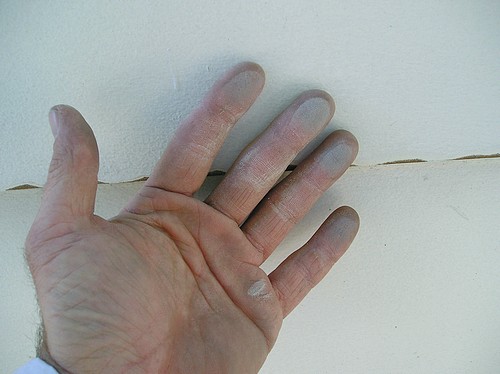Learn The Causes and Remedies For Chalking Paint
A fine, light colored, powdery residue on painted exterior surfaces of your home is chalking paint. This is normal and how all paints wear over time and is considerably better than peeling.
How do you know if your exterior paint is chalky? Easy, simply wipe your hand across the surface using a little pressure. You can use a colored rag instead of your hand. Choose a dark rag for light paint colors and a light rag for dark paint colors. If some of the pigment comes off, usually a light color when compared to your existing paint color, then your existing paint is chalking.
The primary cause is exposure to sunlight.
Ultra violet light breaks down the binders in the paint and releases the pigments. Another cause is a reaction between the binders and oxygen, this is paint oxidation. Both of these processes occur simultaneously and have an effect on all types of finishes.
While all of this chemistry is happening, the paint sheen will become progressively duller and the paint film thinner. The paint film thins from the effects of rain as it washes away the chalking paint residue.
Other Causes and How to Prevent Chalking Paint
Two more aspects of this problem is the type of paint you choose and its quality. Although all paints will chalk over time, some types have a tendency to chalk sooner.
Alkyd paints, aka oil base paint, oxidize faster than most acrylic and latex paints. In most cases, an acrylic paint is a better choice for exterior painting.
Another aspect is the quality of the paint. A general rule is “the more expensive the paint the more and better the resins it has”. The resins are the binders that hold the pigment. When they degrade the pigment is at the surface and appears chalky.
Cheaper paints will degrade faster. An example is exterior 100% acrylic paint verses a latex paint (or acrylic/latex combo paint). The best exterior paints on the market are 100% acrylic, not latex.
Removing the Chalky Residue
This powdery residue must be removed and possibly primed before applying any finish paint. The rules are very simple.
- To remove the residue use a pressure washer and mild, environmentally friendly, soap. Most pressure washers have the ability to dispense cleaners while washing. Use proper pressure washing techniques. Allow the soap to sit on the surface for 10-15 minutes then rinse completely. Repeat the rinsing until all soap residue is gone. Keep the pressure at 1500-2000 psi.
- Allow the surface to dry completely, usually 24 hours. If the amount of chalking paint was excessive or a lot of residue still remains on the surface you will need to apply a quality primer that is appropriate for your application. In most cases an acrylic primer will be a better choice with a severally chalky surface.
Don’t be overly concerned if a little residue is still on the surface. Chances are some will remain, even if you physically scrub your entire house.


